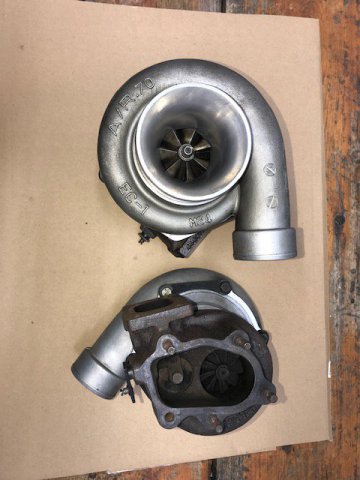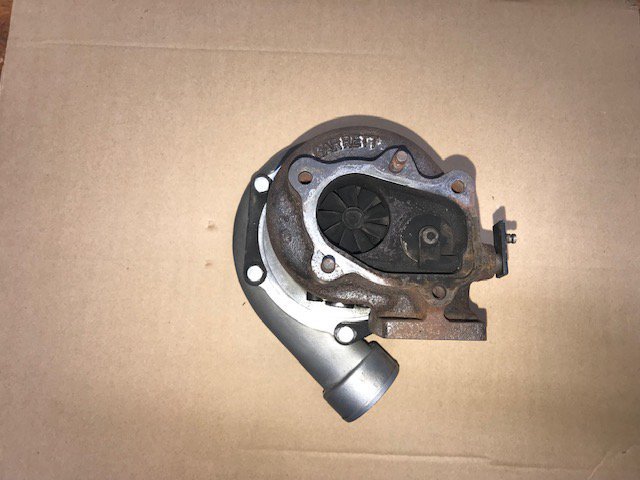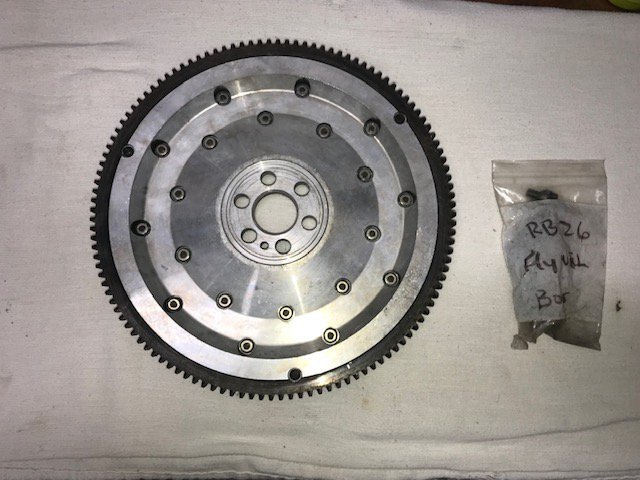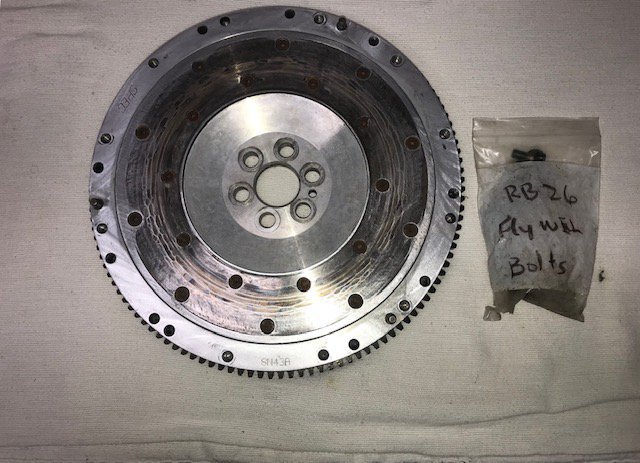
TimO
Members-
Posts
90 -
Joined
-
Last visited
-
Days Won
6
Content Type
Profiles
Forums
Blogs
Events
Gallery
Downloads
Store
Everything posted by TimO
-
Two - Garrett GT2876R Ball Bearing Turbos - will separate
TimO replied to TimO's topic in Parts for Sale
Sold! -
This is part of an estate sale. Two - Garrett GT2876R Ball Bearing Turbos. Will separate. Originally on a twin turbo RB26. $400 each plus shipping. New $1029 each. Very good shape. No shaft play. GT25/40R 280-480hp capability. T25 Flanged Internally Wastegated with built in swing valve. - Dual Stainless Steel Ball Bearings Oil & Water lube/cooled CHRA Specs -Dual Ball Bearing -Oil and water-cooled bearing housing -M14x1.5 water ports Compressor Specs -0.70 A/R compressor housing 4" inlet 2.5" outlet -48-trim compressor wheel 2.08/2.99 52.8mm inducer Turbine Specs -Available in 0.64 A/R and 0.86 A/R turbine housings with T25 inlet internally wastegated -53.9mm 76-trim GT28 Inconel turbine wheel Part Number: 705330-2 - Complete turbocharger with 0.86 A/R turbine housing Dual Ball Bearing GT25/40-R Turbo assembly with specified ar. T25 style inlet flange with 5 bolt style exit. Large 60- 1 style compressor housing with 4.00" inlet and 2.50" outlet. Very Good response turbo for 4 Cyl applications. This turbo has a flow capacity of about 450HP.
-
This is part of an estate sale. SPEC SN43A Flywheel. Asking $125 plus shipping. $456 new! Balanced. CNC machined. Features replaceable steel friction plate. Located in Northern California. Very good condition.
-
STP oil treatment with zinc....DON'T use it.
TimO replied to Ken Smith's topic in S30 Series - 240z, 260z, 280z
Check out this article on the Driven Racing Oil website re zink in oil. http://admin.compperformance.com/news/dro/training-center/articles/proper-use-zdp-engine-oils/ -
It is with much sadness to announce that my very close friend of over 20 years and moderator on HybridZ, Joel Soileau, passed away unexpectedly in his sleep yesterday. He will be sorely missed as a friend to many of us as well as a loyal and dedicated contributor to HybridZ. Rest In Peace my good buddy. http://forums.hybridz.org/profile/181-rb26powered74zcar/
-
Check out ClassicCarSeats.com Expensive but great quality. http://www.classiccarseats.com/avus-seats.php
-
300 hp on a 2400lb Z is awesome. But as Rossman said, power is addictive. 300 hp will only satisfy for a year or so then it feels tame. Next thing you know you want 400+ hp. Ask me how I know! On an L series engine the three main components that people tend to spend more money redoing a second or third time is converting to forged pistons, head/cam, and the heart of the turbo motor...the turbo. If you want 300 hp build for 400. Spend the money once!
-
My 2 cents…. When selecting a turbo, as mentioned above definitely get one with a water cooled center section. If you can afford it, also get one that has ball bearings rather than a sleeve bearing. They last longer and you typically get the latest technology sinc turbo manufactures are putting most of their r&d into ball bearing turbo’s. If you already know this then please disregard my comments. Making horsepower with a turbo is not a function of psi. Psi is essentially a measure of resistance. It’s all about volume of air flow. Not pressure. For example, turbo A might flow lets say 35 lb/min at 17 psi while turbo B might flow 50 lb/min at the same psi and at the same efficiency island. The difference in these turbo examples are typically their size and technology. Flow maps will show you the cfm at various psi for various efficiency levels. Try to match your turbo selection to the cfm (at a streetable psi) required to make your hp target. Then there’s lag to consider. As has been stated above the turbine housing size will affect lag. The smaller the a/r the quicker the spool up but at the same time a small a/r can restrict high rpm performance because of exhaust pressure. I’ve found that a small a/r turbine housing is difficult to drive because it has so much bottom end at the expense of the top end. It’s a matter of preference. I went from a T3 .63 a/r to a T4 .82 a/r. I didn’t notice much of a change in the bottom end but I did notice quite an improvement in the midrange and top end. Again it’s a matter of preference and driving style. Also take into consideration the cfm flow of your head/cam. The cfm of your head and cam (that’s a whole other discussion) will give you a ball park of the max cfm your engine can move which in turn gives you an idea of the turbo cfm your engine can handle. Too big of a turbo and you’re adding more flow than your engine can handle thus creating flow resistance (unequal pressure before and after the turbine housing) while typically introducing increased turbo lag. Too little and you’re leaving hp on the table. Simply, it’s about the amount of cfm required to meet your hp goal, and whether or not your head/cam can flow those cfm numbers. Then select a turbo that makes that amount of cfm, at a streetable psi, at the sweet spot or close to the sweet spot of the turbo’s flow map. And lastly don’t forget to port your turbo exhaust manifold especially where runners 1-2-3-4 come together just before the exhaust flange. The trick is to get everything to work together in balance. Good luck.
-
Very impressive.
-
NA 3.1L=>head & camshaft questions. No shortcuts, max
TimO replied to zredbaron's topic in Nissan L6 Forum
Good luck on the dyno. You should have some really good numbers!!! Can't wait to see your results. -
Miles, well done!
- 21 replies
-
- Indicator
- turn signal
-
(and 2 more)
Tagged with:
-
Exhaust manifold. Hard to find on their website. Go to their prices page and you will see it under Manifold Porting. http://www.lonewolfperformance.com/index.htm
-
Transmission crossmember frame nut possibly crossthreaded?
TimO replied to Stunt's topic in S30 Series - 240z, 260z, 280z
As NewZed said. Work from above. Use a magnet on a sliding extension rod (Harbor Freight and others-cheap) to hold the nut to get the nut started then use a socket from above to hold the nut as you tighten from below. May require an extra set of hands to either hold the nut from above or the bolt from below. Or...more of a permanent fix - assuming you can clean the nut to metal mating surface JB Weld the nut in place from above. Hold the nut with the magnet making sure you don't get any JB Weld on the threads. Leave the magnet attached until the JB Weld dries then bolt from below. JB Weld may or may not permanently hold the nut but either way you will be able to bolt up the trans mount. -
John, These guys http://www.lonewolfp....com/prices.htm also have a service they don't show on their website where they cut the manifold in half, port it, and weld it back together which I understand results in a much better flow than the "standard" porting.
-
John, The OEM exhaust manifold is creating quite an exhaust restriction. Your leaving a lot of flow on the table. It's well work the $ to have it ported. It's not that hard to do yourself. At a minimum focus on where runners 1,2,3 and 4 come together. Or send your manifold to these guys: http://www.lonewolfperformance.com/prices.htm
-
Hey John, Glad to see you back on the forum. I’m running a GTX 3582R. On my new motor I went from a T3 .63 to a T4 .82. I love it! The larger turbine housing seems to be well matched to my new motor which has an offset ground LD28 (85mm) crank, P90 that flows 218 cfm intake 155 cfm exhaust. Aggressive Isky cam .540 lift 270 degrees both sides, 109 lobe center. TWM’s, etc. The T3 .63 ar chocked this motor. The T4 .82 has much more mid range and top end. It bounces off the 7300 rev limiter easily without any warning of drop off. The .63 dropped off a bit before 7300. In terms of spool up/lag. I don’t notice hardly any lag if any. I already have traction problems at low rpms. I don’t have dyno numbers yet but here’s a seat of the pants experience. A buddy with a Superformance Cobra running a 550 hp small block Ford couldn’t keep up with me coming out of corners or on the straights. As we’ve discussed before it’s all about balancing the components and matching air flow characteristics and how you drive. Your motor may work well with a .63. My motor works well with a T4 .82 for road racing. By the way the .82 is easier to drive. It feels more like a big block Chevy than a peaky L6. Call if you want to talk further.
-
I agree. You absolutely need to install expansion joints or some of your welds will crack. Ask me how I know??
-
My 72 240 came with a mechanical fuel pump but the wiring for an electric fuel pump was also installed at the factory. I found the fuel pump wiring ( I think it was a fused green wire but you may want to look at a wiring diagram) behind the radio which ran all the way to the rear near the fuel tank. When I converted to a turbo system and fuel injection I ran a heavy gauge hot wire to a relay in the rear to power the fuel pump and used the factory installed wiring to trigger the relay. I installed a toggle hidden near the driver's seat to switch on/off the relay using the original wiring. You may want to install a roll over stitch as well. Fairly straight forward and easy to do. Good luck.
-
How do I set up vacuum between various turbo components?
TimO replied to dpuma8's topic in Turbo / Supercharger
I used one of these to make a vacuum manifold for my turbo conversion. By the way I'm not that far from you. Nevada City. Let me know if you ever get up this way. http://www.mcmaster.com/#standard-manifolds/=12qzu7m -
Good Luck Leon Tim
-
Leon, Sorry for the delayed response. I used the KD 3087 valve compressor tool: I removed and installed the seals with: http://www.amazon.com/8milelake-Valve-Seal-Remover-Installer/dp/B016JRBZRY?ie=UTF8&keywords=valve%20stem%20%20seal%20removal%20tool&qid=1463926784&ref_=sr_1_3&sr=8-3 If you're ever in the Nevada City area you can borrow them. Or I could USPS send them to you.
-
NA 3.1L=>head & camshaft questions. No shortcuts, max
TimO replied to zredbaron's topic in Nissan L6 Forum
I'm running one of Dave's offset ground 85mm LD28 cranks with his Eagle H beam rods and JE pistons. This is a turbo motor mind you but the sound is still fantastic even with the turbo muffling the sound a bit. More cubic inches is nice but the long stroke/rod ratio improvement in drivability and off boost torque is amazing. On boost is crazy. Worth every penny. -
I recently replaced the valve stem seals in my L6 with the Ford seals with the head on and the engine in the car. Easy to do. Various ways to prevent the valve from dropping, Rope in cylinder through spark plug hole or pressurize cylinder. I used thin clothes line rope. No problems. Worked great. Just remember to put a rag in both ends of the head where the oil drains back into the pan just in case a lash pad jumps off into the abyss of the oil drain passageway. Ask me how I know. The rag did the trick! Good luck.
-
I'm running the same SPEC Stage 5 clutch and flywheel as TimZ. I've had great luck with it. Similar to TimZ's experience I've had no chatter issues. In fact my SPEC Stage 3+ with a six puck sprung hub would tend to chatter but only a little or not at all depending on rpm's. The Stage 5 is not only capable of holding much more torque than the Stage 3, it is actually docile in traffic. I believe the only difference in my set up compared to TimZ's is my aluminum pressure plate option is double clamped, meaning higher spring pressure. Even with the double clamp set up the clutch works great.










